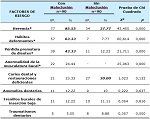Craniocervical posture as a risk factor for malocclusion
Keywords:
craniocervical posture disorders, malocclusion, risk.Abstract
Introduction: craniocervical posture disorders have been viewed as risk factors for orthopedic conditions and as separate conditions themselves, but there are not sufficient studies relating them to dental malocclusion.
Objective: determine whether craniocervical posture disorders constitute a risk factor for malocclusion in patients cared for at Victoria de Santa Clara clinic from October 2012 to February 2013.
Methods: an cross-sectional observational descriptive study was conducted for which two groups were formed: one with patients with malocclusion and the other with patients without malocclusion. Each group was composed of 90 patients. Ocular convergence, head rotation, and biclavicular plane alteration tests were used to determine the prevalence of craniocervical posture disorders.
Results: female gender prevailed in the malocclusion group (55.55 %). The main factors identified were inheritance (85.55 %), deforming habits (63.33 %), premature tooth loss (43.33 %) and oral muscle anomalies (24.44 %). Prevalence of posture disorders was 97.77 % in the malocclusion group vs. 48.88 % in the control group, with a highly significant relationship to malocclusion and an odd ratio of 46.00.
Conclusions: female gender prevailed in the malocclusion group, whereas male gender predominated in the control group. The most prevalent risk factors are those related to malocclusion in a highly significant manner. A predominance was found of craniocervical posture disorders in the malocclusion group, with a highly significant relationship to malocclusion, a factor increasing 46 times the risk of suffering from the condition.
Downloads

Published
How to Cite
Issue
Section
License
Authors retain all rights to their works, which they can reproduce and distribute as long as they cite the primary source of publication.
The Rev Cubana Estomatol is subject to the Creative Commons Attribution-Non-Commercial 4.0 International License (CC BY-NC 4.0) and follows the publication model of SciELO Publishing Schema (SciELO PS) for publication in XML format.
You are free to:
- Share — copy and redistribute the material in any medium or format.
- Adapt — remix, transform, and build upon the material.
The licensor cannot revoke these freedoms as long as you follow the license terms.
Under the following terms:
Attribution — You must give appropriate credit, provide a link to the license, and indicate if changes were made. You may do so in any reasonable manner, but not in any way that suggests the licensor endorses you or your use.
- NonCommercial — You may not use the material for commercial purposes.
No additional restrictions — You may not apply legal terms or technological measures that legally restrict others from doing anything the license permits.
Notices:
- You do not have to comply with the license for elements of the material in the public domain or where your use is permitted by an applicable exception or limitation.
- No warranties are given. The license may not give you all of the permissions necessary for your intended use. For example, other rights such as publicity, privacy, or moral rights may limit how you use the material.

